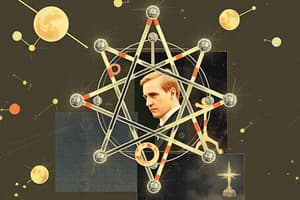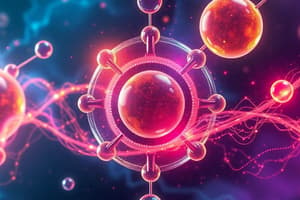Podcast
Questions and Answers
What is a solution primarily composed of?
What is a solution primarily composed of?
- A heterogeneous mixture of solute and solvent
- Only solute
- Only solvent
- A homogeneous mixture of solute and solvent (correct)
Which of the following correctly describes the pH scale?
Which of the following correctly describes the pH scale?
- Ranges from 0 to 14, with 7 being neutral (correct)
- Ranges from 1 to 14, with 0 being neutral
- Ranges from 0 to 20, with 10 being neutral
- Ranges from 1 to 10, with 5 being acidic
What does the Ideal Gas Law equation PV = nRT represent?
What does the Ideal Gas Law equation PV = nRT represent?
- The relationship between mass and energy in a chemical reaction
- The relationship between pressure, volume, and temperature of an ideal liquid
- The relationship between pressure, volume, number of moles, gas constant, and temperature of a gas (correct)
- The relationship between the concentration of a solution and its solubility
What is the primary characteristic of bases in terms of their chemical behavior?
What is the primary characteristic of bases in terms of their chemical behavior?
According to the Law of Definite Proportions, what can be said about a chemical compound?
According to the Law of Definite Proportions, what can be said about a chemical compound?
Which of the following best describes a compound?
Which of the following best describes a compound?
What defines the atomic number of an element?
What defines the atomic number of an element?
What type of bond is characterized by the transfer of electrons?
What type of bond is characterized by the transfer of electrons?
Which of the following accurately describes a gas?
Which of the following accurately describes a gas?
Which reaction type involves the breakdown of a single compound?
Which reaction type involves the breakdown of a single compound?
In which category on the periodic table would you find good conductors of heat and electricity?
In which category on the periodic table would you find good conductors of heat and electricity?
Which of the following states of matter has a definite shape and volume?
Which of the following states of matter has a definite shape and volume?
What type of chemical reaction occurs when a substance reacts with oxygen, producing heat and light?
What type of chemical reaction occurs when a substance reacts with oxygen, producing heat and light?
Flashcards are hidden until you start studying
Study Notes
Key Concepts in Chemistry
Basic Definitions
- Matter: Anything that occupies space and has mass.
- Element: A substance that cannot be broken down into simpler substances by chemical means.
- Compound: A substance formed when two or more elements are chemically bonded together.
- Mixture: A combination of two or more substances that are not chemically bonded.
Atomic Structure
- Atom: The basic unit of a chemical element.
- Composed of protons, neutrons (nucleus), and electrons.
- Protons: Positively charged particles in the nucleus.
- Neutrons: Neutral particles in the nucleus.
- Electrons: Negatively charged particles that orbit the nucleus.
- Atomic Number: Number of protons in the nucleus; defines the element.
- Mass Number: Total number of protons and neutrons in the nucleus.
Chemical Bonds
- Ionic Bonds: Formed through the transfer of electrons from one atom to another.
- Covalent Bonds: Formed when two atoms share electrons.
- Metallic Bonds: Characterized by a sea of shared electrons among metal atoms.
Chemical Reactions
- Reactants: Substances that undergo change in a chemical reaction.
- Products: Substances formed as a result of a chemical reaction.
- Types of Reactions:
- Synthesis: Two or more substances combine to form a single product.
- Decomposition: A single compound breaks down into two or more simpler products.
- Single Replacement: One element replaces another in a compound.
- Double Replacement: Two compounds exchange ions or elements.
- Combustion: A substance reacts with oxygen, producing energy in the form of heat and light.
The Periodic Table
- Organized by increasing atomic number.
- Groups/Families: Vertical columns; elements have similar properties.
- Periods: Horizontal rows; properties change progressively across a period.
- Metals: Good conductors of heat and electricity.
- Nonmetals: Poor conductors; varied physical properties.
- Metalloids: Exhibit properties of both metals and nonmetals.
States of Matter
- Solid: Definite shape and volume; particles are closely packed.
- Liquid: Definite volume but takes the shape of its container; particles are less tightly packed.
- Gas: No definite shape or volume; particles are widely spaced and move freely.
- Plasma: Ionized gas with free-moving charged particles, found in stars.
Solutions and Concentration
- Solution: A homogeneous mixture of solute and solvent.
- Solvent: The substance in which the solute dissolves (typically in larger amount).
- Solute: The substance dissolved in the solvent (typically in smaller amount).
- Concentration: Measure of the amount of solute in a given volume of solution (expressed in molarity, grams per liter, etc.).
Acids and Bases
- Acids: Substances that donate protons (H+) in a reaction.
- Taste sour; turn blue litmus paper red.
- Bases: Substances that accept protons or donate hydroxide ions (OH-).
- Taste bitter; turn red litmus paper blue.
- pH Scale: Measures the acidity or basicity of a solution; ranges from 0 (acidic) to 14 (basic), with 7 being neutral.
Laws of Chemistry
- Law of Conservation of Mass: Mass is neither created nor destroyed in a chemical reaction.
- Law of Definite Proportions: A chemical compound contains the same proportion of elements by mass regardless of sample size.
- Ideal Gas Law: PV = nRT; relates pressure (P), volume (V), number of moles (n), gas constant (R), and temperature (T).
Important Theories
- Kinetic Molecular Theory: Describes the behaviors of gases based on particle motion.
- Atomic Theory: States that matter is composed of atoms, which are indivisible and indestructible.
Laboratory Safety
- Always wear appropriate PPE (gloves, goggles, lab coat).
- Be aware of material safety data sheets (MSDS) for chemical handling.
- Know the location of safety equipment (eyewash stations, fire extinguishers).
Basic Definitions
- Matter is anything that takes up space and has mass.
- Elements are pure substances that cannot be broken down further by chemical means.
- Compounds are formed when two or more elements chemically bond.
- Mixtures are combinations of substances that are not chemically bonded.
Atomic Structure
- Atoms are the smallest unit of an element and are composed of protons, neutrons, and electrons.
- Protons are positively charged particles found in the nucleus of an atom.
- Neutrons are neutral particles also found in the nucleus of an atom.
- Electrons are negatively charged particles that orbit the nucleus.
- The atomic number identifies an element by representing the number of protons in its nucleus.
- The mass number is the total of protons and neutrons in the nucleus.
Chemical Bonds
- Ionic bonds form when electrons are transferred from one atom to another, creating oppositely charged ions.
- Covalent bonds form when two atoms share electrons.
- Metallic bonds involve a sea of shared electrons among metal atoms.
Chemical Reactions
- Reactants are the substances that undergo changes in a chemical reaction.
- Products are the substances formed as a result of a chemical reaction.
Types of Chemical Reactions
- Synthesis combines two or more substances to form a single product.
- Decomposition breaks down a single compound into two or more simpler products.
- Single replacement involves one element replacing another in a compound.
- Double replacement occurs when two compounds exchange ions or elements.
- Combustion is a reaction with oxygen that produces energy in the form of heat and light.
The Periodic Table
- The periodic table organizes elements by increasing atomic number.
- Groups/Families are vertical columns containing elements with similar properties.
- Periods are horizontal rows where properties change progressively.
- Metals are good conductors of heat and electricity.
- Nonmetals are poor conductors with varied properties.
- Metalloids exhibit properties of both metals and nonmetals.
States of Matter
- Solids have a definite shape and volume with tightly packed particles.
- Liquids have a definite volume but take the shape of their container, with particles less tightly packed.
- Gases have no definite shape or volume, with freely moving particles widely spaced.
- Plasma is an ionized gas with free-moving charged particles found in stars.
Solutions and Concentration
- Solutions are homogeneous mixtures of solute and solvent.
- Solvent is the substance that dissolves the solute (typically present in larger amounts).
- Solute is the substance being dissolved (typically present in smaller amounts).
- Concentration measures the amount of solute in a given volume of solution, often expressed as molarity or grams per liter.
Acids and Bases
- Acids donate protons (H+) in a reaction. They taste sour and turn blue litmus paper red.
- Bases accept protons or donate hydroxide ions (OH-). They taste bitter and turn red litmus paper blue.
- The pH scale measures acidity or basicity, ranging from 0 (acidic) to 14 (basic), with 7 being neutral.
Laws of Chemistry
- Law of Conservation of Mass: Mass is neither created nor destroyed in a chemical reaction.
- Law of Definite Proportions: A chemical compound always contains the same proportions of elements by mass regardless of sample size.
- Ideal Gas Law: PV = nRT; relates pressure (P), volume (V), number of moles (n), gas constant (R), and temperature (T).
Important Theories
- Kinetic Molecular Theory: Describes the behavior of gases based on particle motion.
- Atomic Theory: States that matter is composed of atoms, which are indivisible and indestructible.
Laboratory Safety
- Always wear appropriate personal protective equipment (PPE) like gloves, goggles, and a lab coat.
- Familiarize yourself with the material safety data sheets (MSDS) for proper chemical handling.
- Locate and understand how to use safety equipment like eyewash stations and fire extinguishers.
Studying That Suits You
Use AI to generate personalized quizzes and flashcards to suit your learning preferences.




